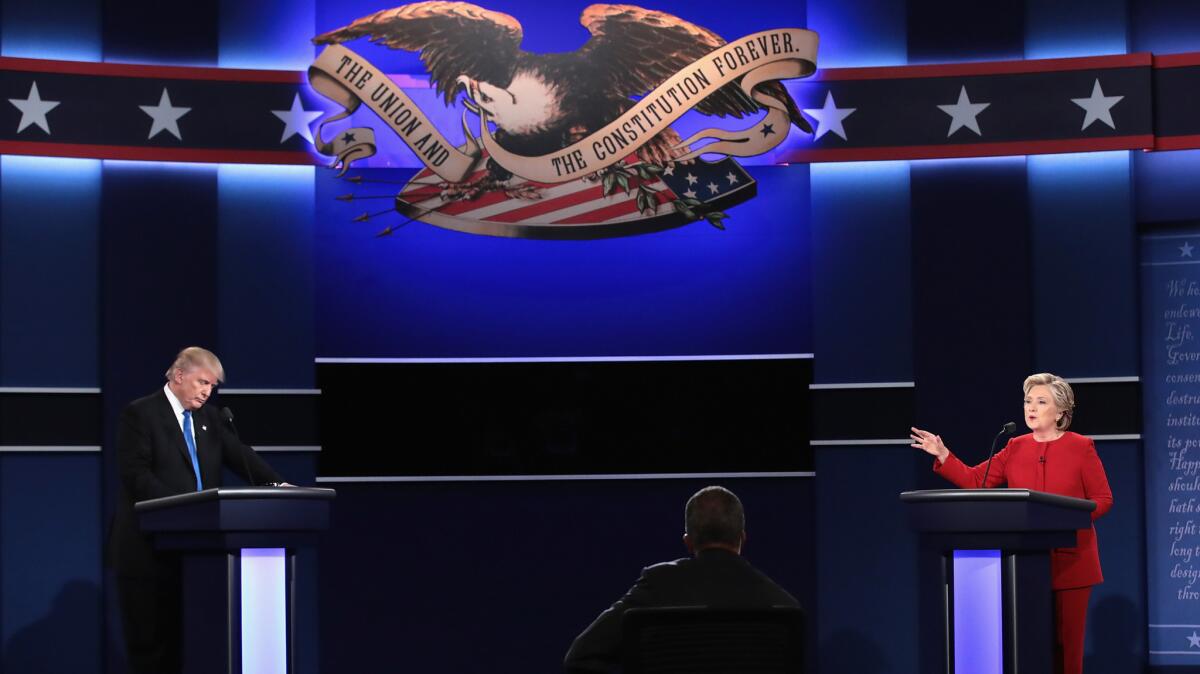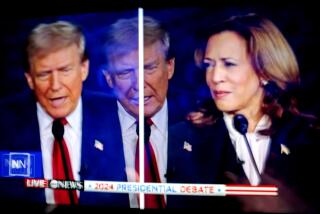Column: The most striking thing missing from the first Trump vs. Clinton debate stage
- Share via
The nonprofit Commission on Presidential Debates, established in 1987, uses a stock, reconfigurable stage design, a kit of sober-looking parts, for each of its nationally televised events. Monday night this portable backdrop was reassembled inside Hofstra University’s David S. Mack Sports and Exhibition Complex in Hempstead, N.Y.: blue carpet with a ring of white stars; wide desk for the moderator, Lester Holt of NBC News; and a blue lectern for each of the candidates positioned in front of a handwritten section of the Declaration of Independence, so that phrases like “it is the Right of the People,” capital R, capital P, hovered over the shoulders of Hillary Clinton and Donald Trump.
A large cutout of an eagle with a banner in its mouth reading “The Union and the Constitution Forever,” which serves as the unofficial seal of the CPD, was hanging over the middle of the stage.
The most striking element of the design was what it was missing: a sense of the crowd, its energy and reactions, and most significant of all — given the way this race has unfolded — what it did and didn’t give itself permission to laugh, smile or cringe at as the night wore on.
The Trump and Clinton camps negotiated nearly every detail of the event — including, reportedly, the temperature of the auditorium — but cheering and audience-reaction shots were off the table, though a bit of applause and some shouts of support, for each candidate, did sneak in near the end.
This enforced quiet, a staple of CPD debates, suited Clinton just fine. She can look at sea in a less formal or unpredictable setting. One of her most effective moments came when she noted that Trump “just criticized me for preparing for this debate. And yes, I did. You know what else I prepared for? I prepared to be president. And I think that’s a good thing.”
If preparation is her brand, this was a good place to advertise it, on a stage that came entirely prepackaged, appointed with patriotic ready-mades.

And it was not necessarily a bad arrangement for Trump. It gave him a chance to look more statesmanlike than he normally does, to appeal to viewers who may have been turned off by the raucous, carnival-like atmosphere that prevails at many of his rallies.
But let’s be honest: The raucous, carnival-like atmosphere that prevails at many of his rallies is precisely what has given his unorthodox candidacy its momentum. This is not just because he’s buoyed by the often raw and visceral enthusiasm of his audiences. It’s also because he relies on the crowd to make his version of speechmaking work.
Trump can go right up to the line of saying something offensive or racially crude but not actually say it, or say all of it. His crowds know what he means, whether the topic is “2nd Amendment people” or “my African American over there”; they fill in the rest of the unspoken thought, the part even Trump dares not say out loud, with their roars.
It is this give and take with an audience that can seem eager to hear him say things that presidential candidates normally don’t say that lends Trump’s campaign stops not just aural but physical, spatial volume. When he chides news crews for not swiveling their cameras around to show the crowds gathered to hear him speak, he is not just trying to brag about the size of the turnout; he is also trying to make his events double-sided, to incorporate the audience into the layout of the rally, into the images that make their way onto the airwaves and the Internet and into newspapers.
Clinton rallies don’t have this quality. I’m not sure any modern presidential rallies have had this quality. The crowd plays the part of Trump’s id.
There were a couple of moments when the Hofstra auditorium expanded on TV just enough to suggest the audience’s presence. Holt admonished the crowd at least once to stay quiet. At other times, on the station I was watching, the cameras turned to frame him, sitting against a pitch-black and cavernous backdrop. You couldn’t see the audience, but you could tell it was there, and you could almost hear it breathe.
In sticking with its format and not showing any members of the crowd, the CPD gave this year’s first debate an added layer of tension it may not have intended to. The pasts of both candidates are unusually crowded with ghosts and the political version of D-list celebrities. Trump mused on Twitter about inviting Gennifer Flowers, a specter from the Bill Clinton presidency, to Hofstra. Clinton supporters countered by mentioning both of Trump’s ex-wives.
Four years ago, I don’t remember wondering who from Barack Obama’s or Mitt Romney’s past might show up embarrassingly at the first debate, or more generally thinking about whether the stage set-up enabled or closed off the relationship between the candidates and the audience.
Monday night was different. This race is different. It has run far hotter than most, stirring up emotions about race, gender and civility that are not typically part of a national campaign.
The Hofstra set design created a tightly sealed container, keeping the most extreme versions of those emotions off-stage. But there are two debates left. We’ll see how well the vacuum holds.
ALSO
Analysis: Trump flinched under Clinton’s criticism, but this race is not over
Round by round: Our analysts say Clinton outpunched Trump
Transcript: The most important exchanges of the presidential debate
More to Read
The biggest entertainment stories
Get our big stories about Hollywood, film, television, music, arts, culture and more right in your inbox as soon as they publish.
You may occasionally receive promotional content from the Los Angeles Times.











